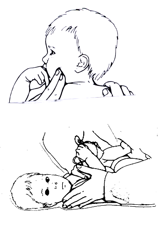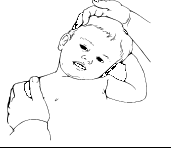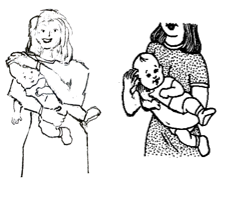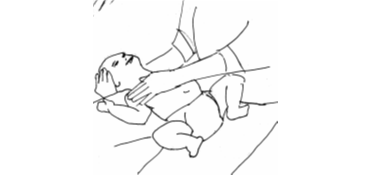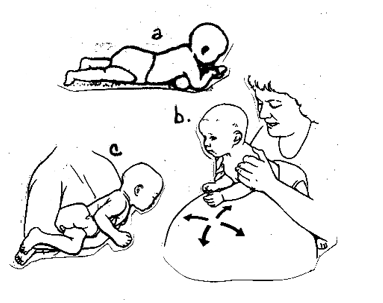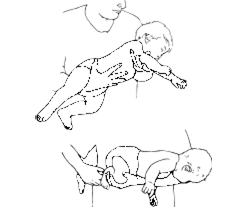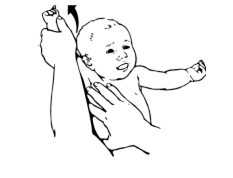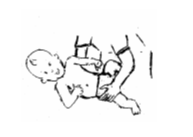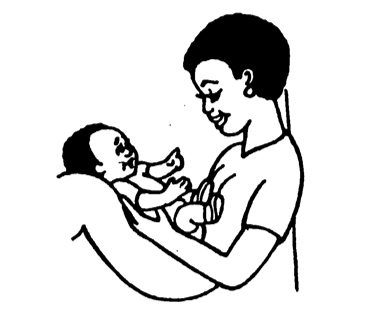Torticollis Left Head Turn Exercise Program
Level One exercise program
What is Torticollis?
Torticollis is also known as “congenital muscular torticollis.” It happens when the muscles in the neck get too tight. Some muscles get strong and other muscles become weak.
- Your baby likes to tilt their head to the right (right ear to right shoulder) and turn it to the left (nose over left shoulder).
- Exercises will help stretch the tight right neck muscle and strengthen the weaker left neck muscle.
If torticollis is not corrected, your baby may have problems with their neck, body, arms, legs, vision or head shape as they grow.
How is torticollis treated?
Exercises and activities will help your baby stretch the muscles that are too tight. It will also help strengthen the weak muscles. You will learn how to do exercises and activities with your baby at home. As your baby grows and develops, you will learn new exercises and activities that will help your baby develop.
Note: It is important for you to lay your baby on their tummy several times a day while awake and supervised. This is called tummy time. By the time they are 4 months old your baby should spend a total of at least 60 to 90 minutes of time on their tummy per day.
Level One exercises and activities for torticollis
Do the following exercises every day. Use very gentle pressure to stretch. Do the stretches when your baby is happy and calm. If your baby resists the stretch, stop stretching and try again later.
Only do these exercises if a physical therapist has talked to you about them.
Call (414) 607-5280 with any questions or concerns.
Neck turn
Note: Use a gentle flat hand instead of fingertips (as shown) to help turn the head or provide pressure at the forehead. Do not press on the jaw. |
Side neck tilt
Hold your baby’s right shoulder so it does not rise up. Then, gently tilt your baby’s head to the left. Move the head so that the left ear moves toward the left shoulder. Make sure the right shoulder does not move when the head moves. Hold this stretch for up to _______ seconds. Do this stretch _____ times. |
Side tilt carrying position
Hold your baby on their right side as your baby faces away from you. One of your arms will be between your baby’s legs. Use your other hand to gently tilt the head to the left by moving your baby’s ear towards the left shoulder. Make sure the right shoulder does not move when the head moves. Hold this stretch for up to _______ seconds. Do this stretch _____ times. You may be standing or sitting when you do this exercise. |
Neck stretch
Put your child on their back over your lap. Support your child’s head with your hand. Slowly lower your child’s head, while holding their shoulders down. Use toys or a mirror to distract your child. |
Tummy Time
|
Tummy carry
|
Shoulder stretch
Have your baby lying on their back or in supported sitting. Gently move the _________ arm up and out toward the head with the thumb side of the hand leading the movement. Your baby’s arm should move far enough to touch their ear. Do not force the movement. Hold the stretch for ______ seconds. |
Side bend flexion
Have your baby lying on their back. Gently curve your baby’s trunk to the left so it makes a “C” shape. Hold the stretch for up to _______ seconds. Do this _______ times. |
Supported sitting
Use this position to help your baby learn to keep their head in a midline, or center, position. Try to get your baby to reach for toys and to reach for their feet while in this position. |
Simple changes that can help your baby’s progress
|
Illustrations courtesy:
Therapy Skill Builders Inc. (3830 E Bellevue, PO Box 42050, Tucson AZ 85733)
Visual Health Information (PO Box 44646, Tacoma WA 98444)
VORT Corporation (PO Box 60132, Palo Alto, CA 94306)




